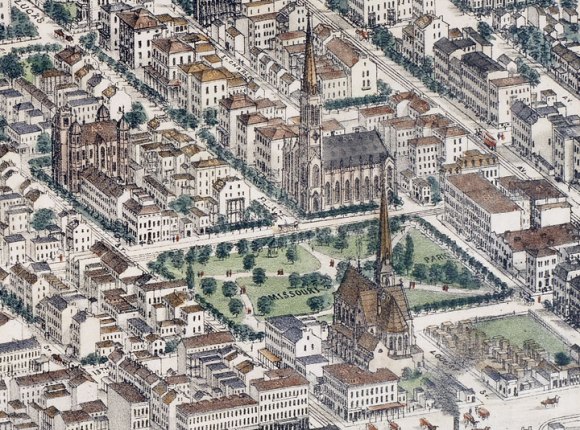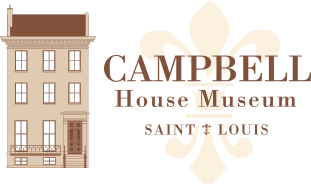The small park behind the St. Louis Public Library is called Lucas Park in honor of the family that once owned the land. In about 1810 Judge J.B.C. Lucas purchased a large parcel of land that includes today’s Lucas Park.
In 1850 the Lucas family developed a new residential neighborhood on their land, which they not surprisingly named Lucas Place. From its conception this neighborhood was intended to be very different with wide building setbacks and deed restrictions banning commercial activities. The new street Lucas Place was also offset 50-feet from the city street grid.

A defining feature of Lucas Place was a new green space called Missouri Park, which the Lucas family had deeded to the city in 1854. Missouri Park was bounded by 13th, Olive, 14th and St. Charles streets. The park stretched across Lucas Place preventing through traffic into the neighborhood and was a key element in defining the neighborhood as “a place apart”. By 1875 Missouri Park boasted, “an iron fountain, 116 benches, 368 shade trees, 277 shrubs, and was surrounded by a wooden picket fence.” It was also the first park in St. Louis to have gas lighting along its pathways.
As commercial development began to encroach on Lucas Place in the early 1880s, Missouri Park was selected as the site for St. Louis’ grandest building of the period, the Music and Exposition Hall. Completed in 1884, this massive building was St. Louis’ first convention center and encompassed the entire 4-acre footprint of the old Missouri Park. Measuring 146,000 square feet the Exhibition Hall hosted the 1888 and 1904 Democratic National Conventions and the 1896 Republican National Convention. The Music Hall sat 4,000 and was the first permanent home to the Saint Louis Symphony.

The Music and Exposition Hall was demolished in 1907 having been replaced by a larger and newer St. Louis Coliseum. The site was then selected for the new St. Louis Public Library, built with a $1 million gift from Andrew Carnegie. Because the Library was designed to use only two-thirds of the old exposition site the northern part of the old Missouri Park was restored to green space and renamed Lucas Park. At the same time Locust Street was cut through the space between the new Library and the restored park. When the street was cut through it resulted in the unusual curve at 13 and Locust streets, which can still be seen today. By 1918 Lucas Park had been planted with “forty-five thousands shrubs and flower plants…set out in artistically designed beds” and was one of the finest parks in St. Louis. After 1950, all the old residential buildings in the vicinity of Lucas Park had vanished (except for the Campbell House) as downtown was transforming into an exclusively commercial district.
Like this post? Look for the new exhibit Lucas Place: The Lost Neighborhood of St. Louis’ Golden Age opening March 22 at the Landmarks Association of St. Louis. Exhibit made possible through a grant from the Missouri Humanities Council.

